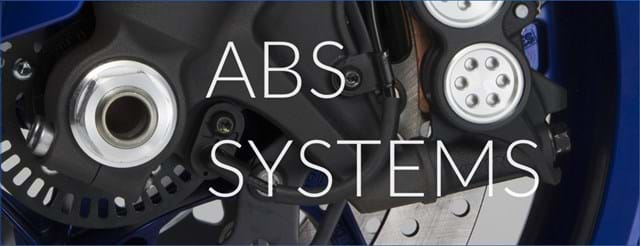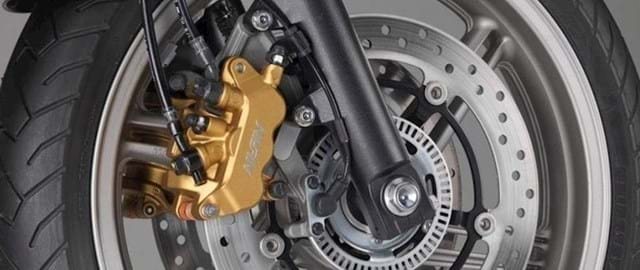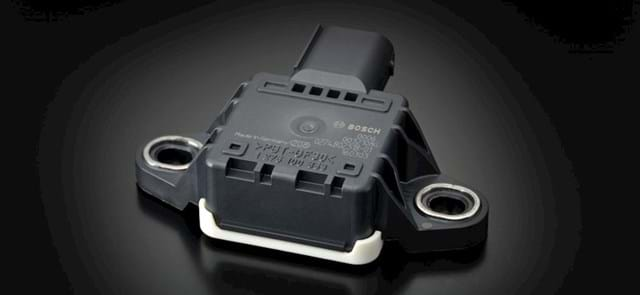Motorbike ABS Systems: The Complete Guide (2022)

On motorbikes and scooters ABS, short for Anti-Lock Braking System, is there to help you brake hard in an emergency or to avoid a crash.
How Does ABS Work On Motorbikes?
Standard ABS systems use a little wheel with regular holes or raised sections within the brake discs. A sensor reads how fast these fly past in order to calculate wheel speed at the front and rear of the bike, which is then fed into a mini computer system in the main section of the bike. You can usually spot the measuring disc and extra cable heading up from the brake to the bike (check out the header image above).
If the computer notices a sudden and large difference in front/back wheel speeds while the bike is slowing down this might indicate that a wheel is about to lock and the ABS system should kick in. When activated the system quickly holds and releases pressure on the brake calipers gripping the brake disc in order to apply a slower and more intermittent braking force.
It basically takes a sudden fist full of brake and spreads it out a bit so the bike still slows down, just without one of the wheels locking up. Here's a quick ABS versus non-ABS video from Honda.
To understand why it's a good idea let's consider what happens if you apply the front brake really hard to the point where it completely stops the wheel turning. Rather than a rotating tyre applying a force left or right, which you are in control of via the handlebars, all you have is one patch of rubber trying to grip the road.
Without ABS the locked up tyre will still push back against the bike, causing it to slow down, just without much control over it heading left or right. This can lead to a few possible outcomes:
1) You plough into the thing directly in front of you that you were trying to avoid because you can no longer steer around it.
2) The front wheel can turn 90 degrees with the back of the bike swinging round to the side, most likely resulting in the bike tipping over and sliding along the road.
3) If the brakes are really powerful, you were going really fast and you didn't apply the back brake you may flip the back end up and over, potentially sending you flying over the handlebars and into the road.
4) A combination of the above!
Standard ABS
Motorbike and scooter models have been increasingly fitted with ABS since the mid 90s but until the mid 2000s it tended to only be found on the larger, faster and more expensive models as more of a value added feature than a standard safety measure.
Despite most cars having ABS for some time that all changed leading up to 2016 when a new EU regulation kicked in demanding that all bikes over 125cc must be fitted with it. This is a good thing because bikes with ABS are far safer for most riders and many of the more premium 125s can be bought with the system as well.
Many of the more expensive bikes now allow the ABS system response to change with the riding mode for even more flexibility, especially post 2017 when pretty much all bikes had to move to over to ECU control system in order to meet the new Euro 4 emission regulations.
One special case to mention is bikes intended to do a lot of off-road work, for example the BMW R1200GS. These usually have an easy to access off mode on the ABS system but some bikes, like the Triumph Tiger 800 XCX, take it even further with a dedicated off-road riding mode; in this case it turns off ABS at just the rear wheel so it can be used to help steer.
Combined-ABS (C-ABS) and Linked Brakes
C-ABS is popular on a lot of Honda models such as the Goldwing GL1800 and VFR1200X Crosstourer. The basic principle is that the front and rear brakes are linked such that applying pressure to one also applies a little pressure to the other, with the aim of spreading out the braking force front to back.
There are a few different systems out there such as the V-Strom 1000 with 2 piston calipers and Honda's more complicated 3 piston caliper setup on older models like the CB1100. On the 3 piston setup the middle piston is operate by the rear brake lever.

Cornering ABS
From circa 2010 some of the really expensive sports bikes (e.g. Yamaha R1) and touring bikes (e.g. BMW K1600GT) started to be fitted with cornering or "banking aware" ABS systems.
They make use of a new IMU (Inertial Measurement Unit) sensor which feeds into the ABS system, telling the computer which way the bike is leaning on all 3 axes. The technology is similar to that found in most smartphones these days or computer controllers like the Nintendo Wii / Oculus Rift, it's just a bit more rugged to cope with life in a motorbike.

Using the extra data allows the computer to keep the traditional benefits of ABS but with added control to keep your line through a corner under heavy braking.
It all helps to keep things shiny side up and the bike heading in the direction you intended plus some manufacturers are finding other ways to use the new data such as logging it on track on the Yamaha R1 or using it to power cornering headlights on the BMW K1600GTL.
Here's a quick video from KTM on the subject.
